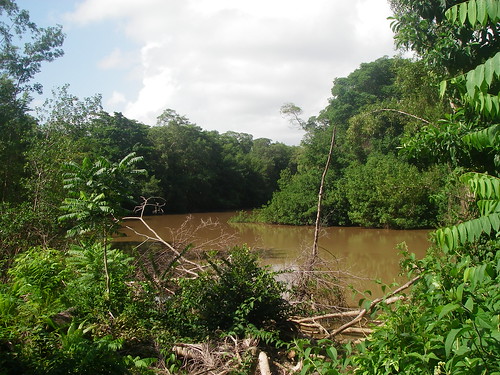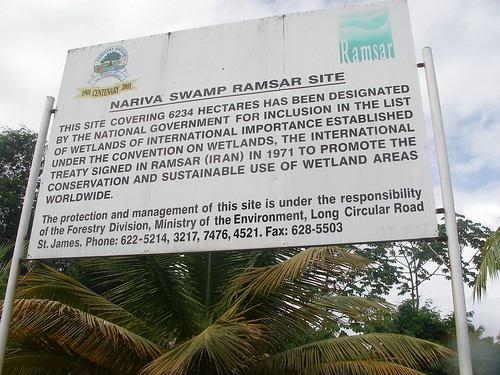Mayaro and the Ortoire River
January 9th 2009
It took me an hour to walk from Mayaro to Ortoire, but I caught glimpses of the river as I approached the village at its mouth. It didn’t strike me as ideal manatee habitat: there were no plants floating on its surface and the water was the colour of strong, milky coffee; turbid with no light able to penetrate far beneath. A dense growth of mangroves pierced the muddy banks with spidery roots. The thicket was impenetrable, even where there was no undergrowth.
Just as my water bottle was about to run out, I passed a small shop with a bench in front of the counter. There were two men sitting there, chatting with the shopkeeper behind the iron grating. I decided to stop for a late brunch of Crix crackers and ice-cold mineral water.
“Manatees?” one of the men asked, as if he hadn’t heard correctly. “Ah, sea cows! Yes, we have them here. They’re further upriver”
I glanced doubtfully at the mirror-calm water, visible through the open door at the back of the shop. “You wouldn’t have any kayaks around here, would you?”
No, they had no kayaks. Fishing is done from engine-driven pirogues, but thankfully most of them were facing out to sea.
Not so long ago manatees were hunted in this area, but from talking to the men I got the impression that they were proud of the creatures. They agreed enthusiastically that Trinidad and the Nariva Swamp are of unique importance for their conservation. We talked about how few of them there were left in the swamp (just over twenty, from what I’d heard), how slowly they breed and how long they live. I gained the impression that the animals were safe here, at least as far as the fishermen were concerned.
That was reassuring. So far I had only come across a few hints about research and conservation efforts in the area. Having made the abrupt decision to come here—far from any internet connection—there hadn’t been much time to finds out more.
With my thirst and curiosity satisfied for the moment, I embarked on the long walk home. Miles upon miles of coconut palms and wind-swept beaches awaited me. And—possibly—bandits.
It was clear that it would be too far to walk.
Less than ten minutes later, I spotted a man and a woman standing by the verge, both dressed like the crews of landscape workers that were clearing the roadsides, incessantly holding back the rampant vegetation with strimmers and rakes—a sight common from Thailand to T&T. They appeared to be off-duty, looking for a lift home. At their feet were a big crate and a double-sized bucket filled to the brim with small, evenly sized pebbles. Each was no larger than my little fingernail but they were oddly symmetric. Leaning closer, I saw that they were tiny clams.
“Chip-chip,” the woman said, and smiled in appreciation of the delicacy.
So that was what was advertised on the mysterious ‘for sale’ signs at some of the houses I had passed. Somehow the name was fitting.
I smiled back at her. “Mind if I join you?”
They didn’t, and they forced the very next truck that passed us to stop, waving their tools at the driver as he made to pass us. I guess the poor man never had a chance.
I climbed into the back—much clumsier than I had done on so many occasions in my youth—and we raced down the road, the wind tearing at my hair.
About seven minutes drive onwards from Ortoire, we passed the RAMSAR sign that marked the entrance to the Nariva Swamp Protected Area.
I felt that I was getting closer.
Tags: Americas, manatees, Nariva Swamp, Travel, Tag Index

February 3rd, 2009 at 15:52
[…] Mayaro and the Ortoire River […]